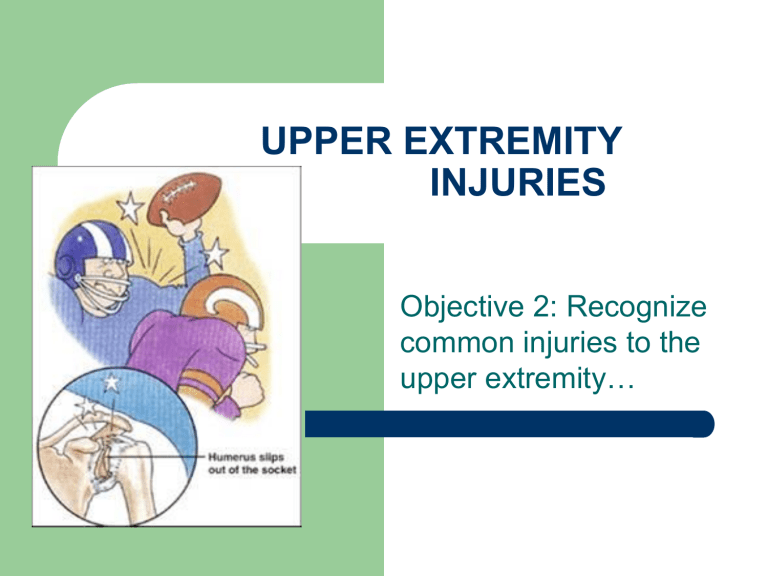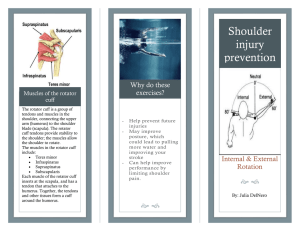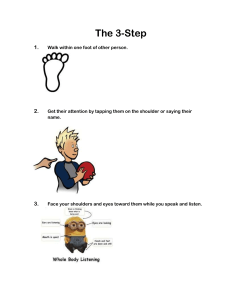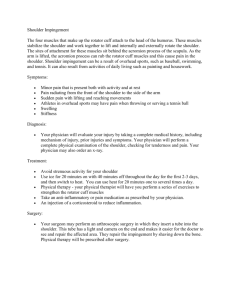Upper Extremity Injuries: Mechanisms, Symptoms, & Treatment
advertisement

UPPER EXTREMITY INJURIES Objective 2: Recognize common injuries to the upper extremity… ANATOMY BONES – – Clavicle Scapula – Spine of the scapula Acromion process Glenoid fossa/cavity Humerus Epicondyles ANATOMY BONES – – – – – Ulna Radius Carpals Metacarpals Phalanges JOINTS OF THE SHOULDER GIRLDLE Shoulder – – Acromioclavicular Glenohumeral Elbow Wrist Metacarpal Phalengeal (MCP) Interphalengeal (PIP & DIP) SOFT TISSUES Subacromial bursa – below the acromion process Acromioclavicular (AC) Ligament – connects acromion and clavicle Glenoid Labrumcartilage ring around socket of shoulder MUSCLES Muscle Location Deltoid Supraspinatus (rotator cuff muscle) Covers the shoulder Posterior scapula Infraspinatus (rotator cuff muscle) Posterior scapula Teres minor (rotator cuff muscle) Posterior scapula Subscapularis (rotator cuff muscle) Anterior scapula Biceps Brachii Anterior aspect of the upper arm Posterior aspect of the upper arm Triceps Brachii Function Abducts the arm Abducts the arm, some external rotation of shoulder; stabilizes the head of the humerus. Externally rotates the shoulder; stabilizes the head of the humerus. Externally rotates the shoulder; stabilizes the head of the humerus. Internally rotates the shoulder; stabilizes the head of the humerus. Flexes the elbow Extends the elbow Common Injuries Clavicle Fracture Mechanism of Injury 1. Fall on outstretched arm. 2. Fall on tip of shoulder. 3. Direct impact Signs and Symptoms Pain, deformity, swelling. Treatment Immobilize shoulder. Refer to physician. Prevention Strategies Don' t fall. Common Injuries Impingement Syndrome Mechanism of Injury Mechanical compression of the supraspinatus tendon, subacromial bursa, and long head of biceps tendon. Signs and Symptoms Pain around acromion with overhead arm position. Weak external rotators. Positive empty can and impingement tests. Treatment Restore normal biomechanics. Strengthen shoulder complex muscles, stretch posterior joint capsule, modify activity until asymptomatic. Prevention Strategies Decrease overhead activity, shoulder complex strengthening, improve technique Common Injuries Rotator Cuff Strain Mechanism of Injury Mechanical compression of the supraspinatus tendon, subacromial bursa, and long head of biceps tendon. Signs and Symptoms Pain around acromion with overhead arm position. Weak external rotators. Positive empty can and impingement tests. Treatment Restore normal biomechanics. Strengthen shoulder complex muscles, stretch posterior joint capsule, modify activity until asymptomatic. Prevention Strategies Decrease overhead activity, shoulder complex strengthening, improve technique Common Injuries Glenohumeral Dislocation Mechanism of Injury Forced abduction, external rotation of shoulder. Signs and Symptoms Flattened deltoid contour, pain, disability. Treatment Splint in position found, immediate transport to physician. Prevention Strategies Shoulder complex strengthening. Common Injuries AC joint separation Mechanism of Injury Signs and Symptoms Treatment 1. Falling on an outstretched arm. 2. Direct impact to the tip of the shoulder. Grade I:point tender, painful ROM, no deformity. Grade II: elevation of the end of the clavicle, decreased ROM. Grade III: dislocation of the clavicle, severe pain, loss of ROM. Ice, immobilization of the shoulder, refer to physician. Return to play at return of full strength and ROM. Prevention Strategies Proper fitting pads Strengthening of deltoid muscle. AC Joint Separations Common Injuries Lateral epicondylitis – “Tennis Elbow” Mechanism of Injury Repetitive extension of the wrist. Signs and Symptoms Aching pain in lateral elbow during and after activity. Treatment RICE, antiinflammatory medications, strengthening exercises. Prevention Strategies Proper technique, progressive increase in frequency/intensity of training. Common Injuries Medial epicondylitis – “Little Leaguer’s or Golfer’s Elbow” Mechanism of Injury Signs and Symptoms Repetitive flexion of the wrist. Pain in medial elbow, could radiate down arm; point tenderness, mild swelling. Treatment RICE, antiinflammatory medications, strengthening exercises Prevention Strategies Proper technique, progressive increase in frequency/intensity of training. Common Injuries Interphalengeal Dislocation Mechanism of Injury Blow to the tip of the finger. Signs and Symptoms Pain, deformity, no ROM. Treatment Splint in position found, immediate referral to a physician.





